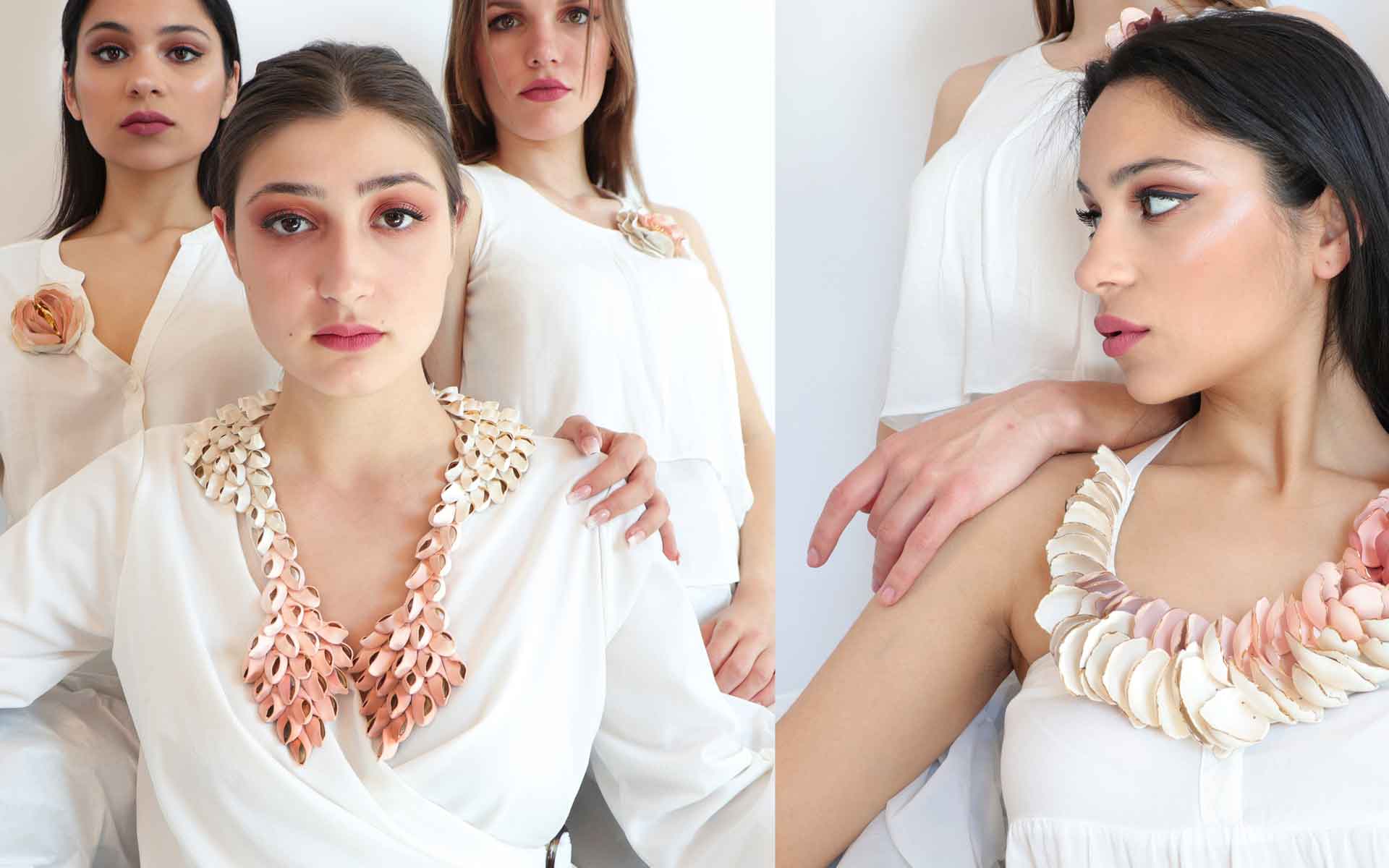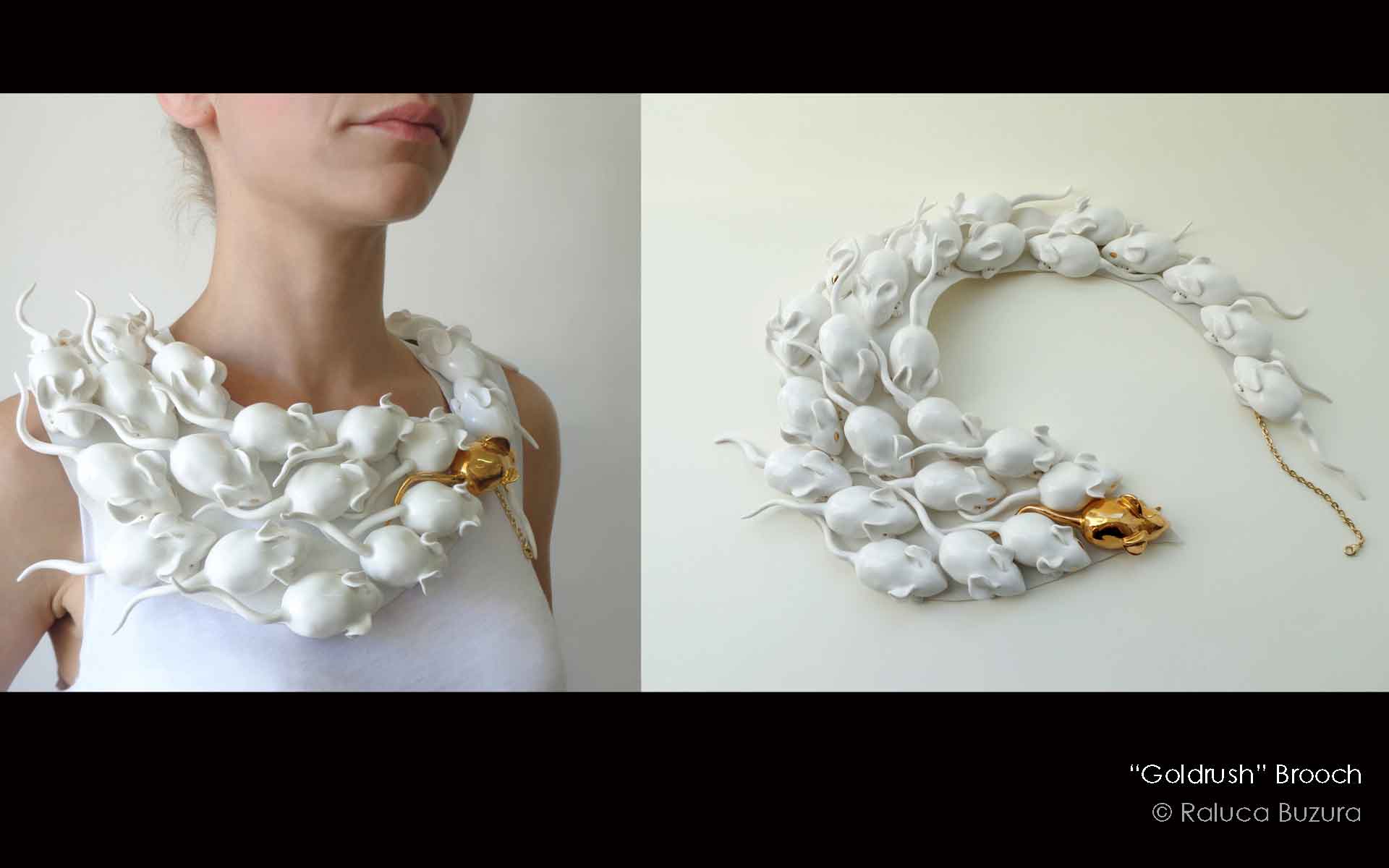
23 May Fashion and Ceramics

Interview with Raluca Buzura, creator of “wearable art installations”
Fashion and ceramics is an inspiring synergy of two different worlds. The contrast of flexible, flowing fabric with the toughness and strength of ceramics can create an intriguing harmony when it comes to what we wear. To learn more about this fascination craft, we interviewed Raluca Buzura, a professional artist with 12 years experience; her work has been shown by publications such as New Necklaces by Nicolas Estrada (cover), Metalsmith Magazine, Vogue Japan and has been awarded with the following prizes: Autor Awesome Award (2018), Collectiva Meeting Award (2018), Faire Magazine Award (2018), Joya Barcelona Award (2019) and a gold medal in the International Design Award (2020).
How did your creative journey with ceramics begin?
My relationship with ceramics has a long history of over 20 years. While being in art high school, the choice of following the ceramic department was just a teenager’s thinking, I chose the group where my closest friends were. After a while, the results started to show up: attending the national contest of ceramics, I won two years in a row the first place which lead to an automatic admission in the ceramic’s department of any Art University in Romania. Even though I was already having a safe spot in ceramics, my preference back then was to follow the fashion design department. It took a short time to realize that my thinking, my heart, my hands were willing to create other kinds of objects, the horizon became clear and I knew I had to return to ceramics.
My first porcelain creations in university were utilitarian design and installations. But because I always had a passion for clothing design, and because at the same time I prefer processing the porcelain into the visual complexity of an installation, over time, these passions have merged into artistic jewelry creation, what I like to call: wearable art installation.
Later on, while following a master in the ceramics department of University of Arts and Design in Cluj-Napoca, Romania, I had my first approach to what jewelry design means and I can say now that the road to jewelry creation was not a premeditated one, nor was I aware of the moment when it became my main activity; everything went from close to close, with small steps, without even thinking for a moment that I was developing a career, an aspect that I still do not perceive in this way, for me is a passion, a way of expressing my inner self and the way I’m reading this world and translating it through material.

What are your inspirations and influences?
Sources of inspiration can be found everywhere around us, from the material to the spiritual world. There are some elements that awake in me a certain interest, and then filtered through mental connections they get translated into a concept which in the end gets the material shape. I can find inspiration in music, architecture, nature, visual art, society, feelings, positive or negative events, I just have to dig deep enough inside of me to find what affects and interests me.
Along the time, I’ve been treating different subjects, each one with the task of emphasizing some of the principles which interests me and influences my being directly:
TIME: the series of pieces called 14.612 minutes that represents the amount of time I spent in the studio working on the collection, because in the end, reduced to an abstract thought, what I offer to the public is my time that received a material shape… and what is the most precious thing above everything, if not the time that we have?
LOVE: in the collection called Tell me where it hurts/hearts the most – depicting parts of our body that are filled with emotions -from joy to pain- all these being a part of the most intense human interaction that we call love relations.
SOCIETY: in the piece Gold rush- a metaphor of the society that is permanently running to achieve material fortunes in their limited lives, like a herd of mice hypnotized by its “golden” leader.
NATURE: collection called Where the almond trees and wind mills are – an epic for the redefinition of the self through nature.
ACTIVISM for the marine life, in the collection called Extinct species – a meditation upon the beauty of marine life that could extinct, trying to bring awareness and to find new ways to engage people in thinking and taking action on critical issues of climate change and extinction due to human intervention.
FEMININITY in the collection called SHE – a journey into the beautiful and sensual side of the female body.

Fashion and ceramics may feel like two very different worlds… What is your vision for the two coexisting?
Generally speaking, contemporary jewelry and fashion are two disciplines tightly related as they are both referring to the human body, they are both wearable arts. I believe they have the role of supporting each other. You might say that fashion can exist without jewelry, but not the other way around…but I would dare to ask you: do you like eating your food without salt, without condiments? This is how I see it, a statement jewelry always comes to complete an outfit, to give that extra taste…and also because a handmade piece can build a special connection in between the creator and the wearer.
How do you plan your projects? Do you have a specific process that you employ each time?
It always starts with an experience that has a great impact on me and most likely in that specific moment I am not fully aware it will convert into something. By time, if the effect of it persists, I begin to analyse it and draw some conclusions, then I decide to release all this energy and my considerations about it into an object. The second phase would be searching for the best visual ways of expressing it by sketching it. When everything clarifies it begins a long process. The ceramic technological process is a complex one and involves a preparation of manufacturing with a large volume of work.
I realized through my first years of activity that being an artist does not resume just to the creation, but it means several other jobs that I need to do when a piece or collection is finished: from taking good pictures and editing them, to writing texts, communicating with clients, promoting my work, packing and shipping it, selling it, doing accounting. There are at least seven other jobs that I’m doing and for all of them I need to be a professional, or at least to try my best to improve it, because any error made in one of these, means consequences, at the end of this chain there is the client that has to be satisfied with the purchase and I am totally responsible for all of these to go right. The main responsibility though remains to provide a piece which is mastering an impeccable technique that harmonizes with the idea and that collide the right aesthetic qualities, therefore are three defining factors I follow: concept, aesthetics and technique.

Your designs are incredibly complex and intricate, what techniques do you use to achieve these stunning results?
Coming from the installation field and with a strong passion for fashion design, I guess something very scenographic remained in my approach; I like to make compositional experiments which I consider to be the most expressive side of my jewelry.
I like to play with textures, different shapes and compositions, sometimes camouflaging the porcelain in a different appearance and thus intriguing the viewer on the material. At the chromatic level, depending on the message of the collection, I will choose a range of colours that best convey the idea, but always with a gold accent, because reaching a small dose of gold creates contrast, brings light and visual richness.
To achieve this aesthetic, I use many different techniques depending on the model, though the process in general is more or less the same. First, is the prototyping in plaster or clay and making moulds in plaster, then, before moving on to the casting or modelling part, it is the preparation of porcelain with high temperature pigments. Once the pieces are dry, they can be polished, glazed and passed through the first firing (1250 degrees Celsius). After the first firing comes the gold application and the second firing (800 degrees Celsius), and the last, assembly, for which is required patterning and sewing. It is a process that can take up to one month until one piece is finished, lots of waiting time, so the patience has to be my closest friend.
It was a long road of research and experiments until I managed to define my own style, because this involves self-analysis and self-knowledge, an aspect that is acquired only in time and patiently, to the point where the creation identify with what you feel, think, live… with yourself!

Porcelain is known for being a temperamental material to work with, what is your experience of creating with porcelain?
Just as other artists prefer colour, sounds or words to express their ideas, porcelain is the material that I feel closest to, it is the one that obeys and listens best to my thoughts. Although I have experienced several materials, I always went back to porcelain for the qualities it has: – from liquid to solid, the technical possibilities to work it are endless; it can be modelled, casted, cut, glued, carved … etc, it’s amazing how much this material has to offer. It goes a long way to becoming an object, coming from the earth in its initial form as mineral silicate, processed into a liquid viscous matter, then submitted to ideas and hands, it takes shape. The porcelain is one of the few materials that bring wonder and astonishment when gets to the final status of the process, from a viscous matter turns into a noble and precious material.
The surface of it is very smooth and after firing becomes translucent, allowing light to show through it. Once burned, it cannot return to the initial state, it no longer allows any kind of intervention on the form, which although at first impression seems to limit you, in reality disciplines you: it pushes you to think everything in advance.
Another property that I love about the porcelain is fragility – and most of the people consider this a minus, a negative side and I would really like to change this point of view. I always say to the people: think of its resistance to the fire, you might not see it that fragile as so many other materials that burn instantly, or think of your grandmother’s set of dishes that you still have it in your kitchen cabinet! After all, I realized that this overrated idea of fragility brings a deeper cherish to the piece itself making it more precious and more noble.
What advice do you have for ceramicists and/or fashion designers?
When smiling satisfied while having an opening in a gallery, most likely very few will be aware of the countless hours of work were behind, tests and experiments, how much you invested, how many kilometres you’ve been travelling before you got there, just to expose yourself in full sincerity, being vulnerable in front of any criticism might come….and even though all your effort might seem pointless, never give up! Because there is nothing more satisfying than being able to produce a piece of art that will stand alive for years and nothing more rewarding than the freedom of creating and living as you choose!

Do you have your own personal philosophy for ceramics? (thoughts on function vs aesthetic, methods, materials, purpose, sustainability etc?)
There are many types of ceramics in this world and a lot of techniques to produce them. Beyond that, we live in times when technological innovations tend to take on the role of the human factor more and more, and in all this technological vortex is pursued rather increased productivity, respectively profit. As a result, the market is flooded with an infinity of objects produced in series and the true value which consists in identity, emotion, uniqueness is too little known by the general public. These values are essential to my creation, it is the ground on which I create and I live. I wish people being more conscious about the way they consume. We have to be wise in the activities that we involve ourselves as they end up defining who we are.
Every time I am trying to transmit a message to the public, and lately is has been an activist one, it is regarding the environment. One of my collections was addressing the environmental issue. This collection called Extinct Species refers to the threat of marine life due to irrational human behaviour and activities. The pieces are a meditation upon the beauty of marine life that could extinct, trying to bring awareness and to find new ways to engage people in thinking and taking action on critical issues of climate change and extinction due to human intervention. Then, the very last collection called Bleached is making reference to the coral bleaching. This is another relevant aspect in my work, but not only transmitting a certain message, but also taking care, myself, of the materials and process, of having an eco-friendly activity, of not polluting or having residual waste that could harm our environment.
Finally, what are your big aspirations and goals for your ceramic practise?
At the level of creation, I consider that I am just starting the age of artistic maturity, it is the moment when I become more and more aware and decant the essential things that I want to transmit through what I do. As for the future, we never know what lies ahead. I always took things from close to close, with small steps and without having many expectations. What is certain is that I will continue to focus on creation and offer the best in me, because when we give, we contribute to the way we want the world to be, and then all the ways in which you enrich the world will come back to you…
Written by Freya Saleh

